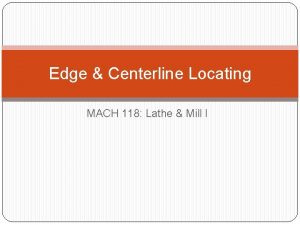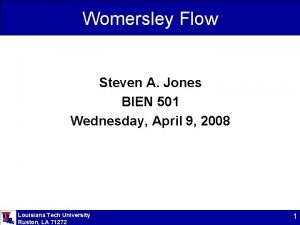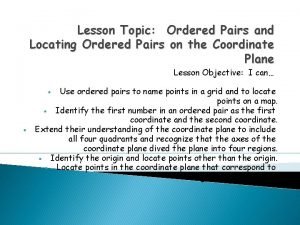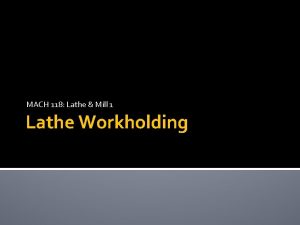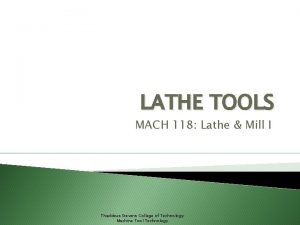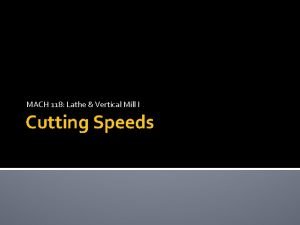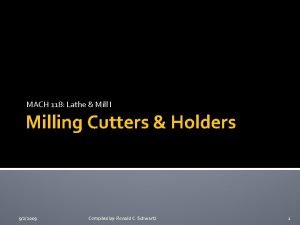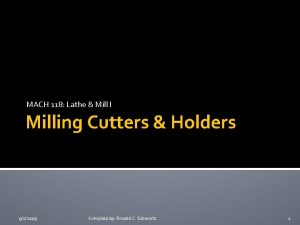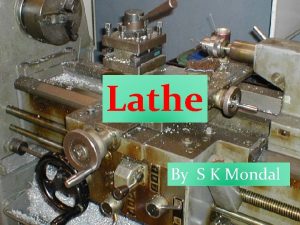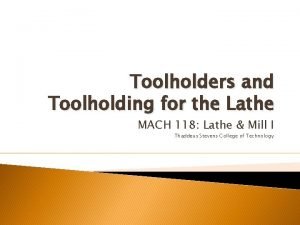Edge Centerline Locating MACH 118 Lathe Mill I











- Slides: 11

Edge & Centerline Locating MACH 118: Lathe & Mill I

SETUPS ON THE VERTICAL MILLING MACHINE Edge and Hole Centerline Locating �After a workpiece has been set up on the mill, it may be necessary to position the machine spindle relative to the edge of the part or to center the spindle over an existing hole. �Edge finding and centerline finding are common operations that you will encounter almost daily in general milling machine operations. Compiled by: Ronald C. Schwartz 09/14/09

SETUPS ON THE VERTICAL MILLING MACHINE tab Using an Edgefinder �A useful tool for edge finding is the offset edgefinder, which consists of a shank with a floating tip retained by an internal spring. �The edgefinder tip is accurately machined to a known diameter, usually. 200 or. 500 in. Fig. J-38 Offset edgefinder (Courtesy of The L. S. Starrett Co. ). Compiled by: Ronald C. Schwartz 09/14/09

1 HOW TO DO IT… �Step 1 Secure the edgefinder in a collet or chuck in the machine spindle. �Step 2 Set the spindle speed to about 600 to 1000 rpm, and slide the edgefinder tip over so that it is off center. �Step 3 Start the spindle and lower the quill or raise the knee so that the edgefinder tip can contact the edge of the part to be located. Compiled by: Ronald C. Schwartz 09/14/09

HOW TO DO IT… l 2 Using an Edgefinder �Step 4 Turn the table or saddle cranks & move the workpiece until it contacts the rotating edgefinder tip. �Slowly advance the workpiece against the edgefinder tip until the tip suddenly moves sideways, & stop movement. �The spindle is positioned a distance equal to half of the edgefinder tip diameter from the edge of the workpiece. �Repeat twice to confirm workpiece position & machine dial readings, or the digital display. Compiled by: Ronald C. Schwartz 09/14/09 Fig. J-39 Work approaching the tip of the offset edgefinder.

3 HOW TO DO IT… �Step 5 When you are sure that the positioning is correct, lower the workpiece or raise the spindle and set the DRO display or the table and saddle micrometer collars to zero. �Move the table or saddle the additional. 100 in. in the same direction that it was moving as it approached the workpiece. �This will prevent introduction of a backlash error owing to slack in the table or saddle nuts. Compiled by: Ronald C. Schwartz 09/14/09

SHOP TIP: Craftsmanship tab � When work requires accurate table movements, backlash must be considered. � When a digital readout is not available on your milling machine, use a dial indicator with a measuring capacity of 1 in. or more. � When this dial indicator is fitted with a magnetic base and clamped on the machine, it will measure exact table movement regardless of the play (backlash) between the nut and leadscrew of the machine. � Watch the dial while tightening the locking levers & make corrections before making a wrong cut. Compiled by: Ronald C. Schwartz 09/14/09

Centerline Locating Compiled by: Ronald C. Schwartz 09/14/09

l 1 Using a Dial Indicator � Step 1 Mount a dial test indicator in the spindle. � Step 2 Move the indicator contact point so it touches the side of the hole. �Set the indicator bezel to zero. • Step 3 Rotate the spindle 180 degrees. Compare the two indicator readings & split the difference between them by moving the machine table. Locate the spindle center first in one axis, then in the second axis. • Step 4 If the hole is not round or Compiled by: Ronald C. Schwartz 09/14/09 Fig. J-40 Dial indicator used in locating the center of a hole.

Edgefinders Compiled by: Ronald C. Schwartz 09/14/09

Review Questions �How fast should the spindle be turning when using an edgefinder? �What are the typical diameters found on edgefinders? �What must be done after touching the surface of the work with an edgefinder and before setting final location? Compiled by: Ronald C. Schwartz 09/14/09
 Mutoharoh
Mutoharoh Centerline
Centerline Centerline velocity formula
Centerline velocity formula Powerschool centerline
Powerschool centerline Vertical wall like structure enclosing a compartment
Vertical wall like structure enclosing a compartment Engineering drawing lettering ratios
Engineering drawing lettering ratios Rising edge and falling edge
Rising edge and falling edge Directly stated main idea
Directly stated main idea Locating places on earth
Locating places on earth Four ways of locating the ethical in you
Four ways of locating the ethical in you Locating the epicenter using triangulation method
Locating the epicenter using triangulation method Locating ordered pairs on the coordinate plane
Locating ordered pairs on the coordinate plane

